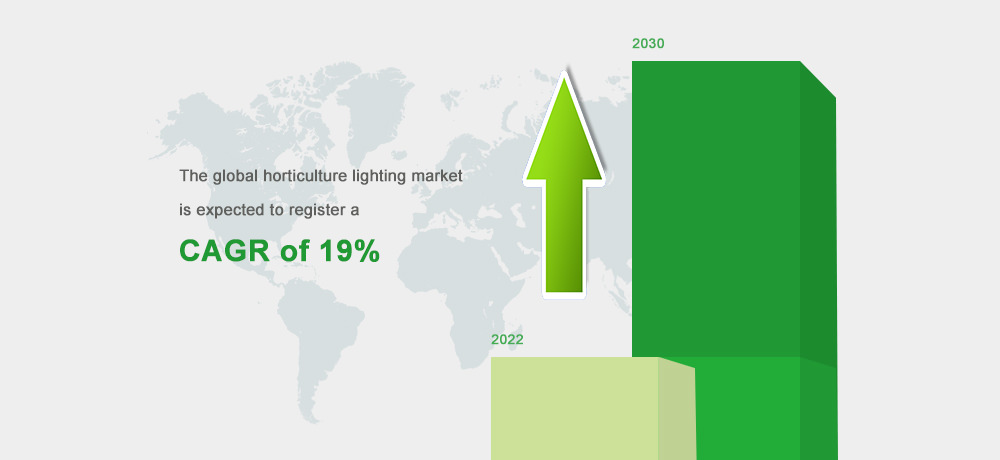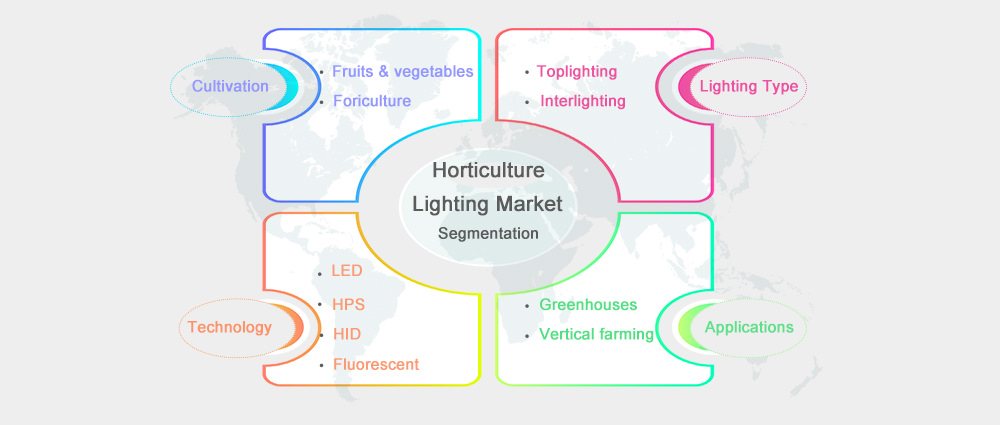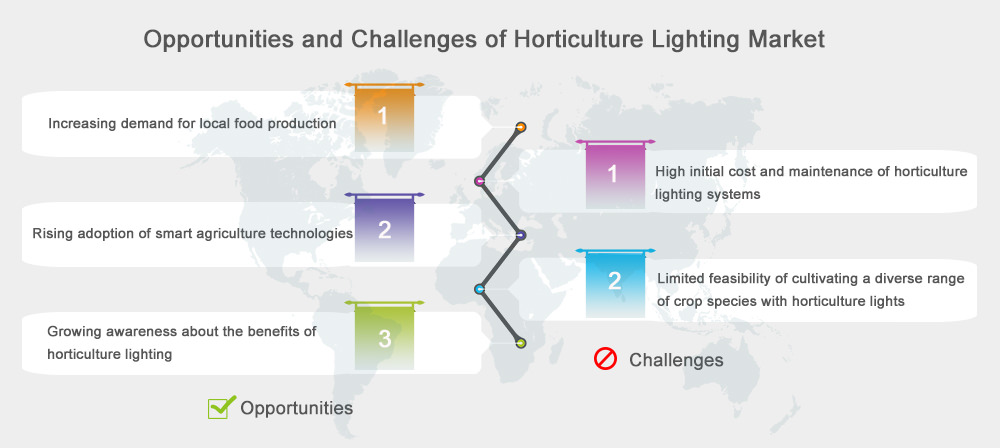The Opportunities and Challenges of Horticulture Lighting Market by 2030
According to the research, the global horticulture lighting market is expected to reach USD 19 billion by 2030, growing at a CAGR of 19% from 2022 to 2030.

Horticulture lighting refers to the lighting used for horticulture and garden cultivation. The horticulture lighting supplements natural daylight and raises light levels to enhance photosynthesis, thereby supporting the plant growth and development. Because horticulture lighting provides artificial light that meets the plants’ needs, it helps boost the yield and quality throughout the year. More and more greenhouses or indoor farms utilize horticulture lighting for large-scale and professional operations. It can be used for various plants, such as vegetables, fruits, and floriculture.
Global horticulture lighting market segmentation
The global horticulture lighting market is segmented based on cultivation, lighting type, technology, and applications.
- On the basis of cultivation, the market is segmented into fruits & vegetables and floriculture. Fruits and vegetables are cultivated on a much larger scale compared to floriculture.
- On the basis of the application, the market is divided into greenhouses, vertical farming, indoor farming, and others. Greenhouses are expected to be the most popular applications for horticulture lighting.
- Based on the lighting type, the market is separated into top lighting, interlighting, photoperiodic supplemental lighting, and sole-source lighting. The toplighting segment has the largest market share.
- Based on technology, the market is bifurcated into LED, HPS, HID, and fluorescent. LEDs are expected to dominate the market due to their long lifespan, low energy consumption, and high quality.

Horticulture lighting market analysis
The global COVID-19 pandemic has been staggering, with the horticulture lighting market experiencing a slight decline in demand across different regions compared to pre-pandemic levels. Affected by the epidemic, UVC LEDs are becoming popular for their disinfecting function. It also drives the usage of UVC LEDs for horticulture lighting to support food supply. With the tame epidemic, the demand for horticulture lighting products and solutions has increased. Growers are seeking for more efficient lighting solutions for indoor agricultural environments. To address the need, LED manufacturers develop horticulture lighting solutions to enhance cultivation. The global horticulture lighting market is expected to reach USD 19 billion by 2030, with a CAGR of 19% from 2022 to 2030.
Opportunities of horticulture lighting market
The horticulture lighting market has a positive growth due to many factors, including the increasing demand for local food production, the rising adoption of smart technologies, and growing awareness about the benefits of horticulture lighting.
Increasing demand for local food production
The demand for local food is increasing day by day. Local food production shortens the transportation distance, which ensures the nutritional values and freshness of food. It also reduces the energy consumption for transporting the food from farms to restaurants and shops. Whether it is to support the local economy, reduce the carbon footprint, or enjoy fresher food, people are becoming more interested in local food production. This drives the demand for horticulture lighting. Horticulture lighting provides the optimal lighting conditions that crops need throughout the year. With the help of CEA (Controlled Environment Agriculture), horticulture lighting enables farmers to grow crops year-round with better quality.
Rising adoption of smart agriculture technologies
Advanced CEA (Controlled Environment Agriculture) and LED technologies are becoming the first choices for large-scale cultivation. Affected by the increasing demand for local food as well as the advancements in greenhouse and vertical farming cultivation, the adoption of smart agriculture technologies is on the rise. CEA offers farmers the potential to increase productivity, lower production costs, and adopt more sustainable farming practices. It enables farms to make data-driven decisions based on real-time information, which helps optimize the use of limited resources such as water and energy and improve crop yields. Horticulture lighting is one of the most important factors in CEA. LED technology is making horticulture lighting more efficient and cost-effective.
Growing awareness about the benefits of horticulture lighting
Indoor farming and greenhouses are becoming more and more popular in urban areas to address the need for organic and fresh food. The legalization of cannabis for medicinal and recreational use also drive the adoption of indoor farming. Horticulture lighting can supplement natural daylight or be the sole light source for crops even in regions with limited access to natural light. Horticulture lighting, especially LED grow lights, can provide plants with a specific spectrum of light that is tailored to their specific needs. By adjusting the light spectrum, intensity, and duration, growers can manipulate plant growth, flavor, color, and other characteristics to suit market needs. The growing awareness of the benefits of horticulture lighting is driving increased adoption of horticulture lighting.
Challenges of horticulture lighting market
Although horticulture lighting is beneficial for plant growth and development and is expected to have a promising growth, the horticulture lighting market is facing its own challenges. These include the high initial cost and maintenance as well as the limited feasibility of cultivating a diverse range of crop species.
High initial cost and maintenance of horticulture lighting systems
Horticulture lighting is widely used to grow plants indoors. There are many different sources of horticulture lighting, including HPS, electric ballasts, LEDs, etc. But horticulture lighting can have a high initial cost and require ongoing maintenance. These costs can be significant for large-scale cultivation. In addition, ongoing maintenance such as replacing bulbs can add up over time. Earlier, HPS lights dominated the horticulture lighting market. Nowadays, LEDs are in trend. Compared to traditional light sources, LEDs are more efficient. LEDs also have longer lifetimes, which help offset some of these expenses. However, most LED grow lights on the market feature high prices.
Limited feasibility of cultivating a diverse range of crop species with horticulture lights
Different types of plants have different requirements in terms of light intensity, spectrum, and duration, which makes it challenging to grow a diverse range of crops using the same lighting system. Some crops require a specific light spectrum. For example, leafy greens require blue light, while fruiting crops like tomatoes and cucumbers require red light. Furthermore, different crops have different growth habits that may require specific lighting configurations, which can be challenging to adapt to all kinds of crops using a single lighting system. Luckily, recent advancements in horticulture lighting technology have made it possible to grow a wider range of crops than ever before. LED horticulture lighting manufacturers like Atop Lighting have some horticulture lights equipped with adjustable light spectrum, intensities, and light distribution capabilities, making it possible for growers to customize lighting conditions to suit a variety of crops at different stages of growth.

In conclusion, the horticulture lighting market will experience promising growth by 2030. While there may be challenges in using horticulture lights, new solutions and advancements in lighting technology and farming practices provide opportunities for the growth of horticulture lighting.

